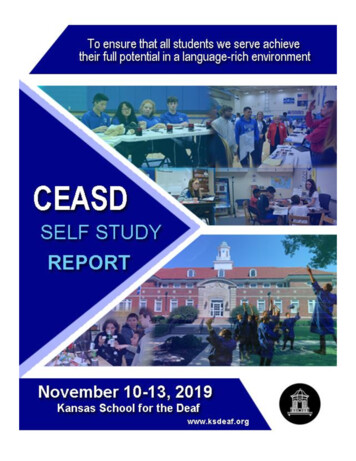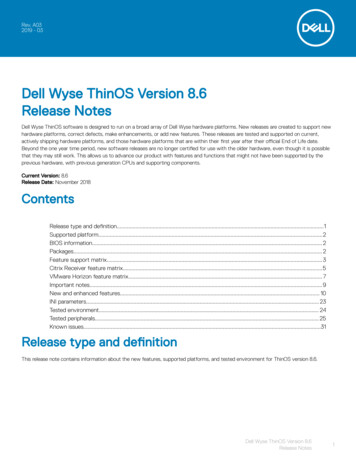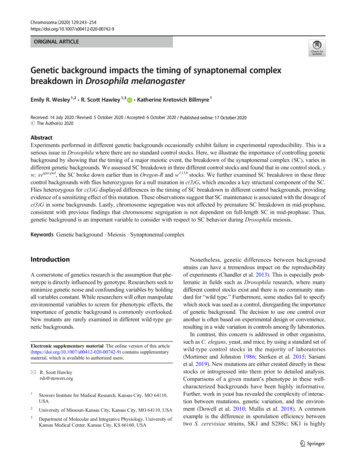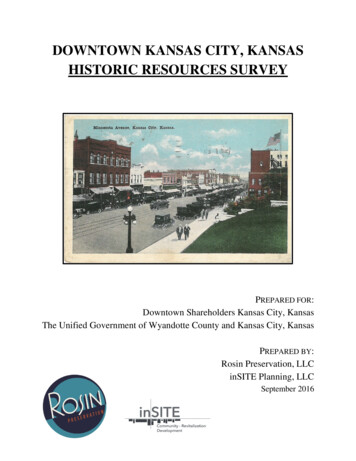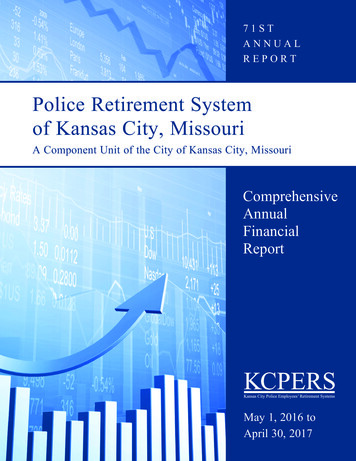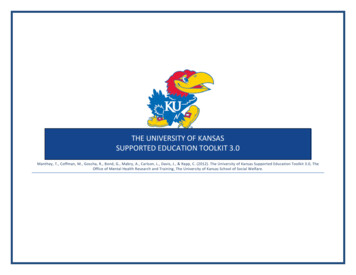
Transcription
THE UNIVERSITY OF KANSASSUPPORTED EDUCATION TOOLKIT 3.0Manthey, T., Coffman, M., Goscha, R., Bond, G., Mabry, A., Carlson, L., Davis, J., & Rapp, C. (2012). The University of Kansas Supported Education Toolkit 3.0, TheOffice of Mental Health Research and Training, The University of Kansas School of Social Welfare.
Supported Education Toolkit 3.02OVERVIEWThe University of Kansas (KU) Supported Education Toolkit is meant to provide information and assistance for fidelity reviewers andsupported education implementation sites. This toolkit is divided into four sections. Section 1 introduces and provides informationon the KU supported education fidelity scale as well as instructions and protocols. Section 2 provides sample tools for fidelityreviewers that assist with conducting supported education fidelity reviews. Section 3 provides sample tools for implementation sitesthat assist with tracking essential supported education information. Section 4 is a bibliography of supported education relatedarticles or books.The average supported education fidelity review should take between one and two days. It is recommended that new fidelityreviewers receive mentorship from experienced supported education fidelity reviewers familiar with the toolkit and protocols.Receiving mentorship may help to avoid implementation drift and increase the speed of implementation in general.If you have feedback or questions regarding this fidelity scale please contact Trevor Manthey, LMSW, Ph.D. Candidate attrevormanthey@gmail.com.
Supported Education Toolkit 3.0TABLE OF CONTENTSSECTION 1: The Supported Education Fidelity Scale and Protocol. 4Development History . 5The KU Supported Education Fidelity Scale . 7The KU Supported Education Fidelity Scale Protocol . 14Introduction 15Fidelity Assessor Checklist 18Item Definitions and Scoring . 23SECTION 2: Tools for Fidelity Reviewers. 44Overview 45Cover Sheet .46Chart Review Tool 47Interview Guide . 50Sample Fidelity Review Report . 63SECTION 3: Tools for Implementation Sites . 74Overview 75Referral Form . 76Educational Assessment and Goal Planning Form 77Present Situation 77Educational History . 78Interest Inventory . 79Assessing Educational Strengths and Interests . 82Barriers to Education Check Sheet 84Current Resources and Needed Resources . 86Educational Goal Plan . 87Disclosure Form 88Quarterly Update Checklist . 91SECTION 4: Bibliography. 95Bibliography . 953
Supported Education Toolkit 3.0SECTION 1:The Supported Education Scale and Protocol4
Supported Education Toolkit 3.05DEVELOPMENT HISTORYThe evidence for supported education thus far does not constrain program development into one narrow model. Therefore, the aimof the KU SEd fidelity scale is to provide a principle-driven model that is likely to be of use in a variety of settings and programs. Asused here "fidelity" means concordance with principles rather than adherence to key elements of programs proven effective.The KU Supported Education fidelity scale was initially developed through using an expert panel of six researchers, a review of otherfidelity scales currently available, individual interviews (with general consumers, students with psychiatric disabilities, communitymental health staff, and community college staff), three large focus groups, and a review of the literature. The KU SEd fidelity scalehas been piloted at three separate community mental health centers in Kansas and revised based on the piloting process in thesecenters. The scale has also been adopted by SAMHSA and has been used by other supported education agencies across the country.Current revisions to the scale were based on a national study of integrated supported education and supported employmentprograms (Manthey, et al., 2012), a focus group of nine SEd provider agencies in Kansas, and a panel of seven KU researchers. Theaim of the latest revision was to make the scale more adaptable to a variety of integrated models (such as an integrated supportededucation/employment model) which is consistent with the original adaptability goals of the scale.Reference:Manthey, T. J., Rapp, C. A., Carlson, L., Holter, M. C., & Davis, J. K. (2012). The perceived importance of integrated supportededucation and employment services. Journal of Rehabilitation, 78(1), 16-24.
Supported Education Toolkit 3.06Current KU SEd Fidelity Scale Iteration (3.0)Iteration 3 (3.0)Manthey, T., Coffman, M., Goscha, R., Bond, G., Mabry, A., Carlson, L., Davis, J., & Rapp, C. (2012). The University of KansasSupported Education Fidelity Scale 3.0, The Office of Mental Health Research and Training, The University of Kansas School of SocialWelfare.Previous KU SEd Fidelity Scale IterationsIteration 2 (2.0)Davis, J. K., Rapp, C., Holter, M., Coffman, M. & McDiarmid, D. (2008). The University of Kansas Supported Education Fidelity Scale,The Office of Mental Health Research and Training, The University of Kansas School of Social Welfare.Iteration 1 (1.0)McDiarmid, D., Rapp, C., Holter, M., Dykes, D., & Ratzlaff, S. (2006). The University of Kansas Supported Education Fidelity Scale, TheOffice of Mental Health Research and Training, The University of Kansas School of Social Welfare.
Supported Education Toolkit 3.07THE UNIVERSITY OF KANSASSUPPORTED EDUCATION FIDELITY SCALE 3.0Manthey, T., Coffman, M., Goscha, R., Bond, G., Mabry, A., Carlson, L., Davis, J., & Rapp, C. (2012). The University of Kansas Supported Education Fidelity Scale, TheOffice of Mental Health Research and Training, The University of Kansas School of Social Welfare.
Supported Education Toolkit 3.0Staffing and Organizational Factors1.Provides All Phases: The person providing supported educationservices provides all phases of the supported education process(referral, engagement, assessment, enrollment support, and ongoingeducational support).2A. Integration with Mental Health Treatment: The SupportedEducation team is integrated with mental healthtreatment as illustrated by: (1) attending at least one casemanagement team meeting per month, (2) attending all CM teammeetings quarterly, and (3) having at least three client-relatedcontacts per week with CM’s.2B. Integration with Mental Health Treatment: The SupportedEducation team is integrated with mental healthtreatment as illustrated by: (1) attempting to recruit new clients atCM team meetings, and (2) coordinating services at CM teammeetings 3) During individual CM contact, inquiring about possiblenew referrals from case managers’ caseloads.3.Educational Outcomes: The Supported Education team: (1) tracksoutcomes including: (a) % in education (b) % completed (c) GPA (d)withdrawals/terminations, (e) # of credits, and (f) type of degreeprogram. (2) the outcomes tracked and shared on a semi-annualbasis at a minimum (3) the outcomes tracked are shared withstakeholders (including clients and community members) (4) theoutcomes tracked are shared with staff (5) the outcomes trackedinclude both individual and aggregate data.812345SEd Worker providesonly one phase ofeducation servicesSEd Worker providestwo phases ofeducation servicesSEd Worker providesthree phases ofeducation servicesSEd Worker providesfour phases ofeducation servicesSEd Worker providesall five phase ofeducation servicesSEd staff meet one orzero inclusioncriterionSEd staff meet twoout of three inclusioncriteriaSEd staff meet allthree inclusion criteriaSEd staff meet one orzero inclusioncriterionSEd staff meet twoout of three inclusioncriteriaSEd staff meet allthree inclusion criteriaMeet one out of fiveoutcome relatedelementsMeet two out of fiveoutcome relatedelementsMeet three out of fiveoutcome relatedelementsMeet four out of fiveoutcome relatedelementsMeet all five outcomerelated elements
Supported Education Toolkit 3.04A. Caseload Size: Supported Education workers have a total caseload of25 or less for an integrated model (combined supported employmentand supported education caseload).-OR4B. Caseload Size: For the freestanding (nonintegrated) model:Supported Education workers have a total caseload of 35 or less.5.Supervisor’s Duties: Supported Education supervisor ensuresprogram objectives are met by: (1) Providing weekly supervision, (2)communicating with mental health service supervisors quarterly toresolve programmatic issues and to encourage referrals to the SEdprogram, (3) provides field mentoring every quarter, (4) providesindividualized feedback regarding outcomes, and (5) helps developnew strategies and ideas to help clients achieve their educationalgoals.6.Range of Services: The Supported Education program offers servicesindividualized for the specific educational needs of each consumermeant to further career development (e.g. GED/HS diploma, postsecondary education, vocational school, English as a SecondLanguage, basic educational skills, online programs, apprenticeships,etc).912345Integrated caseloadsare 81 or greaterIntegrated caseloadsare between 61-80Integrated caseloadsare between 41-60Integrated caseloadsare between 26-40Integrated caseloadsare at or less than 25Nonintegratedcaseloads are 91 orgreaterNonintegratedcaseloads arebetween 71-90Nonintegratedcaseloads arebetween51-70Nonintegratedcaseloads arebetween 36-50Nonintegratedcaseloads are at orless than 35One out of fiveelements are presentTwo out of fiveelements are presentThree out of fiveelements are presentFour out of fiveelements arepresentFive out of fiveelements are presentTeam offers supportfor only one or twoeducational activitiesTeam offersassistance for someactivities but not a fullrangeTeam offers a fullrange of support foreducational activities(there is no evidencethe team excludes anytype of educationalpursuit)
Supported Education Toolkit 3.0Referral and Engagement123.There is evidence thatinformal or formalscreening hasoccurred one or twotimes.There is no evidenceof informal or formaleligibilityrequirements. Allconsumers are eligible& actively encouragedto participate in theprogram.There is no structuredmechanism in placebut there is evidencethat conversation (s)took place.There is a structuredmechanism used thatensures conversationstake place abouteducation.7.Screening: Consumers are not screened out of Supported EducationServices based on formal or informal educational or non-educationaleligibility requirements such as literacy, substance use, languagebarriers, symptoms, perceived readiness, motivation, age, hygiene,medication compliance, etcThere is evidencethat formal orinformal screeningregularly occurs orhas occurred morethan two times.8.Engaging Communication With All Clients: Case-managers andsupported education workers regularly and frequently talk with all CSSclients about education as an option (e.g. ask clients if they ever thoughtabout it, convey education as a possibility, discuss pro’s and con’s, askclients about their past experience with education, discuss connectionsbetween employment and educational goals, and discuss what theirfuture educational goals might be if they were to pursue it)*No structuredmechanized andevidence ofconversation beyondthe SEd referral9.SEd Program Awareness: Individuals who receive agency services areaware of the educational services provided as evidenced by displaysof SEd program materials (posters, brochures, flyers) that are highlyvisible and are present in multiple locations that consumersfrequent.10A. Services Begin Quickly: Individuals seeking supported educationservices receive their first contact by the supported education teamwithin one week of referral.10B. Services Begin Quickly: Individuals seeking supported educationservices have one concrete educational activity completed withinone month of referral.10Materials have notbeen developedMaterials aredeveloped but arenot displayed ordistributed 45% of cases have avisit the first week.45-59% have a visitthe first week. 45% of cases havecompleted aconcrete educationalactivity within 30days of referral45-59%have completed aconcrete educationalactivity within 30days of referral45Materials aredisplayed in onelocationMaterials aredisplayed at multiplelocations that areeasily accessible60-74% of cases havea visit the first week.75-89% of caseshave a visit the firstweek.90% or more of caseshave a visit the firstweek.60-74% of cases havecompleted a concreteeducational activitywithin 30 days ofreferral75-89% of caseshave completed aconcreteeducational activitywithin 30 days ofreferral90% or more of caseshave completed aconcrete educationalactivity within 30 daysof referral
Supported Education Toolkit 3.011. Assertive engagement and outreach: (phone, mail, email, communityvisits) occurs with new referrals or when a participant stops participatingin SEd services until the individual acknowledges they do not want tocontinue SEd services or re-engage. The following elements should be inplace: 1) a systematic means of tracking outreach efforts 2) SEd workersmake a minimum of five outreach attempts within one month 3) Hascontacted the primary treatment team about the non-engagement.Assessment and Goal Planning1 or 0 elements arepresent112 out of 3 elementsare present3 out of 3 elementsare present1234512. Written Assessment: Educational Support Workers assessparticipants’ (1) educational interests, (2) talents, skills,environmental supports, resources (3) preferences, (4) academichistory, (5) future academic aspirations, (6) barriers to education, and(7) accommodations/support needs and documents their assessmentusing an educational assessment tool. The educational assessment isupdated quarterly with new information based on changes in theparticipants’ life situation.Three or lessdomains aredocumented and/ordocumentation is notupdated regularlyFour domains areregularly assessed.Five domains areregularly assessed.Six domains areregularly assessed.Seven domains areregularly assessed.13. Disclosure: Educational support workers assist participants in makingan informed decision regarding disclosure to school staff, faculty andstudents. An informed decision includes the following: (1) disclosure isnot required (2) offer to discuss pro’s and con’s including how thedecision influences access to accommodations (3) discuss what/howinformation may be appropriately disclosed including examples (4)workers discuss disclosure and revisit it at least quarterly.None of the domainsare presentOne of the domainsare present in eithercharts or consumercommentsTwo of the domainsare present in eithercharts or consumercommentsThree of thedomains are presentin either charts orconsumer commentsFour domains arepresent in both (1)charts and (2)consumer interviewcomments14. Educational Goal Planning: Educational Support Workers provideindividualized educational goal planning that is updated quarterly andmeet these criteria: (1) consumer preferences; (2) includes long-termgoal(s), (3) short-term action steps, (4) date(s) for completion, and (5)responsibilities.Zero or one criterionis/are updatedquarterly.Only two criteria areupdated quarterly.Only three criteria areupdated quarterly.Only four criteriaare updatedquarterly.All five criteria areupdated quarterly.
Supported Education Toolkit 3.0Enrollment/Ongoing Support121234515. Essential Enrollment/Ongoing Supports: At a minimum, the followingservices are provided for individuals beginning enrollment orcontinuing enrollment at an educational institution. 1) application foradmission 2) financial aid 3) books and supplies 4) transportation 5)class schedulingServices are providedto 59% or fewer ofparticipantsServices are providedto 60% - 69%% ofparticipantsServices are providedto 70% - 79& ofparticipantsServices areprovided to 80% 99% of participantsServices are providedto 100% ofparticipants16. Supplemental Enrollment/ Ongoing Supports: At a minimum, thefollowing services are provided for individuals beginning enrollmentor continuing enrollment at an educational institution. 1)familiarization with educational institution 2) introduction to campusresources and personnel 3) tutoring 4) accommodations 5) peersupportServices are providedto 59% or fewer ofparticipants withidentified needServices are providedto 60% - 69%% ofparticipants withidentified needServices are providedto 70% - 79& ofparticipants withidentified needServices areprovided to 80% 99% of participantswith identified needServices are providedto 100% ofparticipants withidentified need17. Ongoing Supports: Ongoing essential and supplemental supports areprovided at least monthly to each SEd client. After preparing clients toattend an academic program (e.g. application for admission, financial aid,coarse schedule) it is part of the SEd staffs’ job to follow the progress ofeach SEd client to provide support, encouragement and to addressneeds in advance (e.g. tutoring, accommodations).Assistance isprovided monthly to 29% of programparticipants.Assistance is providedmonthly to 30-49% ofprogram participants.Assistance is providedmonthly to 50- 69% ofprogram participants.Assistance isprovided monthly to70-89% of programparticipants.Assistance is providedmonthly to 90-100%of programparticipants.18. Financial Assistance: Educational support workers provide assistancein securing financial aid/assistance (i.e. scholarships, grants, VR accessetc.) during enrollment and throughout educational tenure. Theassistance is comprehensive and should cover the following elements:1) gathering relevant financial/academic information (e.g. bankrecords, income tax returns, past academic records), 2) resolving pasteducational loan defaults, 3) exploration of grant/scholarshipopportunities 4) exploration of funding opportunities (e.g. specialprograms, VR, etc) and 5) their potential ramifications.Only 1 out of 5financial aid types ofassistance aredelivered.2 out of 5 financialaid types ofassistance aredelivered.3 out of 5 financial aidtypes of assistanceare delivered.4 out of 5 financialaid types ofassistance aredelivered.5 out of 5 financial aidtypes of assistance aredelivered.
Supported Education Toolkit 3.0131234519. Liaison Services: If disclosure occurs and is based on client identifiedneed and preference, the supported education worker(s) serve as aproactive liaison to educational programs in order to addressparticipant and programmatic issues. Collaboration andcommunication with relevant campus personnel occurs on aconsistent and regular basis.*Assistance isprovided to 29%of programparticipants.Assistance is providedto 30-49% of programparticipants.Assistance is providedto 50- 69% ofprogram participants.Assistance isprovided to 70-89%of programparticipants.Assistance is providedto 90-100% ofprogram participants.20. Individualization: Educational Support Workers provide support thatis individualized by participant’s preferences and needs.*Assistance isprovided to 29%of programparticipants.Assistance is providedto 30-49% of programparticipants.Assistance is providedto 50- 69% ofprogram participants.Assistance isprovided to 70-89%of programparticipants.Assistance is providedto 90-100% ofprogram participants21. Mobile/immediate supports: are available when the student requiresit. A supported educational worker is able to respond when aparticipant needs immediate support (travel to educationalinstitution).Assistance isprovided to 29%of programparticipants.Assistance is providedto 30-49% of programparticipants.Assistance is providedto 50- 69% ofprogram participants.Assistance isprovided to 70-89%of programparticipantsAssistance is providedto 90-100% ofprogram participants.
Supported Education Toolkit 3.014THE UNIVERSITY OF KANSASSUPPORTED EDUCATION FIDELITY SCALE 3.0 PROTOCOLManthey, T., Coffman, M., Goscha, R., Bond, G., Mabry, A., Carlson, L., Davis, J., & Rapp, C. (2012). The University of Kansas Supported Education Fidelity Scale, TheOffice of Mental Health Research and Training, The University of Kansas School of Social Welfare.
Supported Education Toolkit 3.015INTRODUCTIONSupported Education is an emerging best practice in the field of psychiatric rehabilitation. The primary goal of Supported Education is to provideopportunities, resources and support to people with psychiatric disabilities in order to gain admittance to and succeed in the pursuit ofeducation. Education is an activity that enables individuals to gain access to meaningful employment, a new identity, and the fulfillment of lifegoals.Consumers of mental health services and service providers are increasingly recognizing the role of supported education in recovery. Educationalinvolvement parallels recovery; both are on-going processes and both prepare one for new challenges in life. Unfortunately, for peopleexperiencing psychiatric disabilities, involvement in post-secondary or other continued education, though frequently desired, is seldomachieved. For many individuals, the completion of high school, college and trade apprenticeship is interrupted by the onset of identifiablepsychiatric symptoms manifested in the young adult years.Although existing models of Supported Education vary, The University of Kansas Supported Education Group upholds the following as theframework for best practices in Supported Education: Mental health center (MHC) promotes Supported Education throughout the organization and in the greater communitySupported Education activities occur on campusVariety of activities are offered to increase consumer/student confidence & explore educational possibilitiesMental health center sponsored segregated activities are not required and consumer chooses from an array of other non-segregatededucational optionsClinicians, case managers, treatment teams are active in encouraging education with consumersEnrollment and individualized educational supports are providedSupport groups or peer-to-peer assistance is available and accessibleMHC provides necessary help to acquire needed resources on an individualized basisNo exclusion based on mental health or personal considerations for participation in activities of Supported Education
Supported Education Toolkit 3.016What is meant by “participant”:Throughout the protocol and on the Fidelity instrument, the term participant is used. Consumer is a term that is commonly used to describeindividuals who receive mental health services. However, while developing this program it became apparent that a term was needed to identifyindividuals in the Supported Education Program, particularly in agencies providing multiple services.Overview of the scale:The Supported Education Fidelity Scale contains program-specific items that have been developed to measure the implementation of SupportedEducation programs. Each item on the scale is rated on a 5 point rating scale ranging from 1 (not implemented) to 5 (fully implemented). Thestandards used for establishing the anchors for the fully implemented ratings were determined through a variety of expert sources and empiricalresearch.What is rated?The scale is rated on current behavior and activities, not planned or intended behavior. For example, in order to get the full credit for Item 2(Supported Education Team/Specialist), it is not enough that the program is currently planning to hire personnel to fill the position.Unit of analysis:The scale is appropriate for assessing fidelity to Supported Education practices at the agency/program level. Clinicians are rated as a grouprather than on an individual basis.How the rating is done:The Supported Education Fidelity assessment is conducted in person at the program site. The assessment is scheduled in cooperation with theprogram being assessed. The Supported Education Fidelity assessment requires a minimum of 12 hours to complete and is typically scheduledover the course of two days.
Supported Education Toolkit 3.017The data collection procedures include chart review, review of educational handouts, and semi-structured interviews with the SupportedEducation program coordinator, Supported Education practitioners, other clinical staff in the agency, and participants in the SupportedEducation Program.Interviews:It is recommended that if the Supported Education program has 3 or fewer Supported Education specialists, attempts should be made tointerview all. If the program is larger than a staff of 3, try to interview as many as possible. However, a minimum of 3 specialists shouldbe sampled for interview. It is recommended that interviews with Supported Education specialists be conducted in a group setting.It is recommended that other clinical staff (i.e. case managers and therapists) working in Community Support Services and with theSupported Education target population be randomly selected and interviewed. Group interviews should be conducted, selecting at least1 therapists and 1 case managers from each referring team/or at least a total of 3 case managers as respondents.It is recommended that the Fidelity assessors should aim to interview at least 5 consumers who have received or are currently receivingSupported Education services. If possible, interviewing 3 consumers who are not currently receiving services is also recommended. Theideal is that consumers from the Supported Education program are randomly selected.Chart Review:Some items on the Fidelity assessment require chart review. It is recommended that 10% of participant charts be randomly selected andreviewed (from both established and newly enrolled participants) with a minimum of 10 charts. The reviewer may choose to reviewmore charts if compelled to do so.Who does the rating:Using the University of Kansas (KU) Fidelity Scale, assessments can be made by both external groups as well as by the organization implementingSupported Education. Both types of assessments are recommended. If it is administered internally, it is important for the ratings to be madeobjectively and based on hard evidence. Agencies are encouraged to select a review process that fosters objectivity in ratings, e.g., by involvinga staff person who is not centrally involved in providing or supervising Supported Education services. With regard to external reviews, there is a
Supported Education Toolkit 3.018distinct advantage in using assessors who are familiar with the program, but at the same time are independent. The goal in this process is theselection of objective and competent assessors.Fidelity assessment should be administered by persons who have experience and training in interviewing and data collection procedures,including chart reviews. In addition, raters need to have an understanding of the nature and critical ingredients of Supported Education andpopulation served. It is recommended that all Fidelity assessments be conducted by at least two raters in order to increase reliability of thefindings.Missing data:The KU Fidelity Scale is designed to be completed fully, with no missing data on any items. If information cannot be obtained at the time of thesite visit, it will be important for the raters to collect the data by following up with phone calls, emails, or additional site visits. It is critical thatraters record detailed notes of responses given by interviewees.FIDELITY ASSESSOR CHECKLISTBefore the Fidelity Site Visit: Review the sample cover sheet.This sheet is useful for organizing the University of Kansas Supported Education Fidelity assessment, identifying where the specificassessment was completed, along with general descriptive information about the site. You may need to tailor this sheet for your specificneeds (e.g., unique data sources, purposes of the Fidelity assessment). Create a timeline for the Fidelity assessment.Fidelity assessments require careful coordination of efforts and good communication. Therefore, it may be useful to list all the necessaryactivities leading up to and during the visit as well as target dates for completion of these tasks. Establish a contact person at the program.You should identify one key person with whom you arrange your visit and communicate with before the fidelity review. Typically this will bethe Supported Education coordinator. Exercise common courtesy by scheduling well in advance and respecting the competing timedemands on clinicians and other staff.
Supported Education Toolkit 3.019 Establish a shared understanding with the site being assessed.It is essential that the Fidelity assessment team communicates to the program the goals of the Fidelity assessment. Assessors should informthe program site about who will see the report, whether the program site will receive this information, and what information will beprovided. The most successful Fidelity assessments are those in which the shared goal among the assessors and the program site is tounderstand how the program is progressing
The University of Kansas (KU) Supported Education Toolkit is meant to provide information and assistance for fidelity reviewers and supported education implementation sites. This toolkit is divided into four sections. Section 1 introduces and provides information on the KU supported education fidelity scale as well as instructions and protocols.


